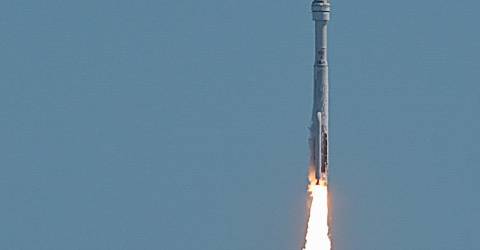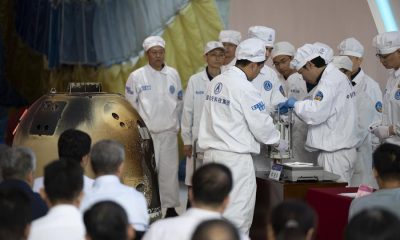Science
NASA insists Boeing Starliner crew ‘not stranded’ on ISS

WASHINGTON: The first astronauts to fly Boeing’s troubled Starliner are definitely not “stranded” at the International Space Station, NASA insisted Friday despite having no clear timeframe for bringing them home.
In an unusually defensive press call, officials attempted to put a positive spin on where things currently stood after weeks of negative headlines due to the spaceship’s delayed return.
Astronauts Butch Wilmore and Suni Williams blasted off on June 5 following years of delays and safety scares affecting Starliner, as well as two aborted launch attempts that came as astronauts were strapped in and ready to go.
They docked the following day for what was meant to be roughly a week-long stay, but their return has been pushed back multiple times because of thruster malfunctions and helium leaks that came to light during the journey.
“Butch and Suni are not stranded in space,“ declared Steve Stich, NASA’s commercial crew program manager.
He added the pair were “enjoying their time on the space station” and “our plan is to continue to return them on Starliner and return them home at the right time.”
Before that can happen, however, ground teams need to run more testing to better understand the root causes.
It was known there was one helium leak affecting Starliner before the launch, but more leaks emerged during the flight. While non-combustible, helium provides pressure to the propulsion system.
Separately, some of Starliner’s thrusters that provide fine maneuvering initially failed to kick in, delaying docking. Engineers are not sure why Starliner’s computer “deselected” these thrusters, though they were able to restart all but one of them.
The thruster testing could begin July 2 and would last at least two weeks, said Stich.
“It is pretty painful to read the things that are out there,“ added Mark Nappi, Boeing’s vice president and program manager of its Commercial Crew Program.
“We’ve gotten a really good test flight that’s been accomplished so far, and it’s being viewed rather negatively.”
Teething issues with new spaceships aren’t uncommon, with the Space Shuttle program facing its share of problems in its early days.
But the Starliner program has suffered from comparisons to SpaceX’s Crew Dragon. Both companies were awarded multibillion dollar contracts in 2014 to provide the US space agency with rides to the ISS, with SpaceX succeeding in 2020 and carrying dozens of people since.
Aerospace giant Boeing’s reputation has also nosedived in the wake of the safety scandal surrounding its 737 Max passenger jets.

Science
Boeing Starliner astronauts ‘are not stranded’ in orbit, NASA insists – Digital Trends

NASA has insisted that its two Starliner astronauts are not stranded in orbit as it continues to investigate issues with the thrusters on the spacecraft. which is currently docked at the International Space Station (ISS).
The Starliner brought NASA astronauts Suni Williams and Butch Wilmore to the ISS on June 6 in what was the first crewed trip for the vehicle. But on the final approach to the orbital outpost, it became apparent that five of the Starliner’s thrusters were not functioning in the correct way.
The thrusters serve to maintain the appropriate orientation of the crew capsule and will be vital for guiding the Starliner toward its reentry into Earth’s atmosphere when the vehicle finally returns home. The agency has also been investigating five helium leaks that occurred on the Starliner during its journey to the ISS.
In a media conference streamed online on Friday, Steve Stich, manager of NASA’s Commercial Crew Program, said: “I want to make it very clear that Butch and Suni are not stranded in space.”
Stich said the plan is to bring the two astronauts back to Earth on the Starliner and that there was no rush to get the pair home.
The original mission would’ve seen Williams and Wilmore spend about a week aboard the station, but their time in orbit is now approaching the four-week mark with no target date announced for their return.
In a worst-case scenario, if engineers deem the condition of the Starliner too risky for the astronauts to travel in, it’s possible Williams and Wilmore could hitch a ride home on a docked Crew Dragon spacecraft operated by SpaceX. Alternatively, they could wait for a SpaceX Crew Dragon to be prepped and sent for them in a similar way to how a NASA astronaut Frank Rubio and two cosmonauts waited for a Russian Soyuz spacecraft after the one they traveled in suffered damage while docked at the station.
Science
New Moon, Planets And Earth Farthest From Sun: The Night Sky This Week – Forbes

Each Monday, I pick out North America’s celestial highlights for the week ahead (which also apply to mid-northern latitudes in the northern hemisphere. Be sure to check my main feed for more in-depth articles on stargazing, astronomy, eclipses and more.
The Night Sky This Week: July 1-7, 2024
The first week of July isn’t exactly the best of the year for sky-watchers in the northern hemisphere—the extremely long nights make sure of that. This week, however, is as good as it gets because, with a new moon mid-week, it’s the darkest the post-sunset skies will get in July. Early risers will see a waning crescent moon and meet some of the prettiest sights of the winter night sky while our planet reaches a significant milestone in its annual journey around the sun.
Here’s everything you need to know about stargazing and astronomy this week:
Monday, July 1: Crescent Moon And Mars
SkySafari (skysafariastronomy.com)
Monday, July 1: Crescent Moon And Mars
If you can get yourself up an hour before sunrise where you are, look east for the pretty sight of a 23%-lit waning crescent moon four degrees above Mars. Closer to the horizon will be bright Jupiter, sandwiched between the beautiful Pleiades open cluster of stars (above) and Aldebaran, the brightest star in Taurus. Capella, the “goat star,” will be to the left, above the northeast.
Tuesday, July 2: Crescent Moon And The Pleiades
SkySafari (skysafariastronomy.com)
Tuesday, July 2: Crescent Moon And The Pleiades
Another early start will get you another beautiful view of the Pleiades, with a now 14%-lit waning crescent moon just a few degrees away. Mars is to the right, Jupiter and Aldebaran are beneath, and Capella is to the left.
Wednesday, July 3: Crescent Moon And Jupiter
SkySafari (skysafariastronomy.com)
function loadConnatixScript(document) {
if (!window.cnxel) {
window.cnxel = {};
window.cnxel.cmd = [];
var iframe = document.createElement(‘iframe’);
iframe.style.display = ‘none’;
iframe.onload = function() {
var iframeDoc = iframe.contentWindow.document;
var script = iframeDoc.createElement(‘script’);
script.src=”//cd.elements.video/player.js” + ‘?cid=’ + ’62cec241-7d09-4462-afc2-f72f8d8ef40a’;
script.setAttribute(‘defer’, ‘1’);
script.setAttribute(‘type’, ‘text/javascript’);
iframeDoc.body.appendChild(script);
};
document.head.appendChild(iframe);
const preloadResourcesEndpoint=”https://cds.elements.video/a/preload-resources-ovp.json”;
fetch(preloadResourcesEndpoint, { priority: ‘low’ })
.then(response => {
if (!response.ok) {
throw new Error(‘Network response was not ok’, preloadResourcesEndpoint);
}
return response.json();
})
.then(data => {
const cssUrl = data.css;
const cssUrlLink = document.createElement(‘link’);
cssUrlLink.rel=”stylesheet”;
cssUrlLink.href = cssUrl;
cssUrlLink.as=”style”;
cssUrlLink.media=”print”;
cssUrlLink.onload = function() {
this.media=”all”;
};
document.head.appendChild(cssUrlLink);
const hls = data.hls;
const hlsScript = document.createElement(‘script’);
hlsScript.src = hls;
hlsScript.setAttribute(‘defer’, ‘1’);
hlsScript.setAttribute(‘type’, ‘text/javascript’);
document.head.appendChild(hlsScript);
}).catch(error => {
console.error(‘There was a problem with the fetch operation:’, error);
});
}
}
loadConnatixScript(document);
(function() {
function createUniqueId() {
return ‘xxxxxxxx-xxxx-4xxx-yxxx-xxxxxxxxxxxx’.replace(/[xy]/g, function(c) {
var r = Math.random() * 16 | 0,
v = c == ‘x’ ? r : (r & 0x3 | 0x8);
return v.toString(16);
});
}
const randId = createUniqueId();
document.getElementsByClassName(‘fbs-cnx’)[0].setAttribute(‘id’, randId);
document.getElementById(randId).removeAttribute(‘class’);
(new Image()).src=”https://capi.elements.video/tr/si?token=” + ’44f947fb-a5ce-41f1-a4fc-78dcf31c262a’ + ‘&cid=’ + ’62cec241-7d09-4462-afc2-f72f8d8ef40a’;
cnxel.cmd.push(function () {
cnxel({
playerId: ’44f947fb-a5ce-41f1-a4fc-78dcf31c262a’,
playlistId: ‘aff7f449-8e5d-4c43-8dca-16dfb7dc05b9’,
}).render(randId);
});
})();
Wednesday, July 3: Crescent Moon And Jupiter
By now, the waning crescent moon will have shrunk to just 8% illumination, giving it a slender look that’s hard to beat—if you can find it. Look low to the east-northeast horizon, and you’ll find our slim-looking satellite close to bright Jupiter. Capella, the Pleiades and Mars will form the backdrop above the pair.
Friday, July 5: Earth At Aphelion And A New ‘Buck Moon’
Earth orbits the sun in a slightly elliptical path, which causes the distance between the two to vary throughout the year. Today marks the farthest point in Earth’s orbit from the sun, known as “Aphelion Day.” At its closest point, or perihelion, on January 2, 2024, Earth was 91.4 million miles (147 million kilometers) from the sun, while today it’s 94.5 million miles (152 million kilometers) distant, according to timeanddate.com.
Today, we also see the new “Buck Moon,” which ensures dark moonless skies and, from Sunday, the emergence in the twilight of a slender crescent moon. The New Moon phase puts our natural satellite roughly between Earth and the sun, so it’s completely invisible to us—the exception being when it causes a solar eclipse, as it did in April (a total solar eclipse) and will again in October (an annular solar eclipse, this one observable only from the Pacific Ocean and South America).
Saturday, July 6: Young Moon
SkySafari (skysafariastronomy.com)
Saturday, July 6: Young Moon
The sky-watching week ends with a couple of post-sunset moon-planet conjunctions. Be looking west-northwest after the sun has set and you’ll have a chance to see a 1.3%-lit waxing crescent moon, it having emerged from the sun’s glare. Just below the moon will be bright Venus, though it will be very hard to see.
Sunday, July 7: Crescent Moon And Mercury
SkySafari (skysafariastronomy.com)
Sunday, July 7: Crescent Moon And Mercury
Tonight, you’ll have a chance to see a 5%-lit waxing crescent moon just above Mercury, which may require binoculars. Venus is to the lower right above northwest, but again, you’ll struggle to see it.
The Lagoon Nebula is a bright, diffuse nebula in the southern constellation Sagittarius; cataloged … [+]
getty
Binocular Target Of The Week: Lagoon Nebula (M8)
Nothing beats the sight of the Orion Nebula (M42) in winter, but the Lagoon Nebula (M8) comes closest. Covering a region of the night sky about three times the size of the moon, this bright emission nebula in the constellation Sagittarius will be visible above the south. It’s just to the right of the tip of the lid of the famous “teapot” asterism. You’ll need binoculars.
Binocular Target Of The Week: Lagoon Nebula (M8)
SkySafari (skysafariastronomy.com)
The Lagoon Nebula is about 5,200 light-years from the solar system and, like M42, is where stars are being born. The light you see is the ultraviolet radiation from its young stars, ionizing its dust and gas. This is what the Hubble Space Telescope sees.
The times and dates given apply to mid-northern latitudes. For the most accurate location-specific information, consult online planetariums like SkySafari Pro, Stellarium and The Sky Live. Check planet-rise/planet-set, sunrise/sunset, and moonrise/moonset times to see where you are.
Follow me on Twitter/X and Instagram.
Pick up my books Stargazing in 2024, A Stargazing Program For Beginners and When Is The Next Eclipse?
Wishing you clear skies and wide eyes.
Science
Space race: Is China ahead of the U.S.? – CNBCAfrica.com

China’s Chang’e-6 lunar probe completed a 53-day mission on June 25, returning with the world’s first soil samples from the far side of the moon recently.
The U.S. and China share similar goals of sending crewed missions to the moon by 2030 and establishing a base on the lunar South Pole.
But is an international space race sustainable? #CNBC #Short #SpaceRace
—–
Subscribe: http://cnb.cx/2wuoARM
CNBC International TV: https://cnb.cx/2NGytpz
LinkedIn: https://www.linkedin.com/showcase/cnbc-international/
TikTok: https://www.tiktok.com/@cnbci
Facebook: https://www.facebook.com/cnbcinternational
Instagram: https://www.instagram.com/cnbcinternational/
Threads: https://www.threads.net/@cnbcinternational
X: https://twitter.com/CNBCi
Telegram: https://t.me/cnbci
WhatsApp: https://bit.ly/CNBCiWhatsApp
Mon, 01 Jul 2024 11:15:00 GMT
-

 Investment16 hours ago
Investment16 hours agoRivian Soars After Volkswagen Investment. Is It Too Late to Buy the Stock?
-

 Science16 hours ago
Science16 hours agoBearing China’s lunar exploration endeavors in mind
-

 News23 hours ago
News23 hours agoAre you proud to be Canadian? Poll suggests fewer people are feeling that way
-
Media14 hours ago
Russian media says Kanye West visiting Moscow
-
Business15 hours ago
WestJet flight cancellations hit tens of thousands of travelers
-
Real eState15 hours ago
The U.S. Real Estate Market in Charts
-

 Sports16 hours ago
Sports16 hours agoMaple Leafs Re-sign Forward Max Domi | Toronto Maple Leafs
-

 Sports17 hours ago
Sports17 hours agoSpain beats Georgia 4-1 to reach Euro 2024 quarterfinals. It next plays host Germany





